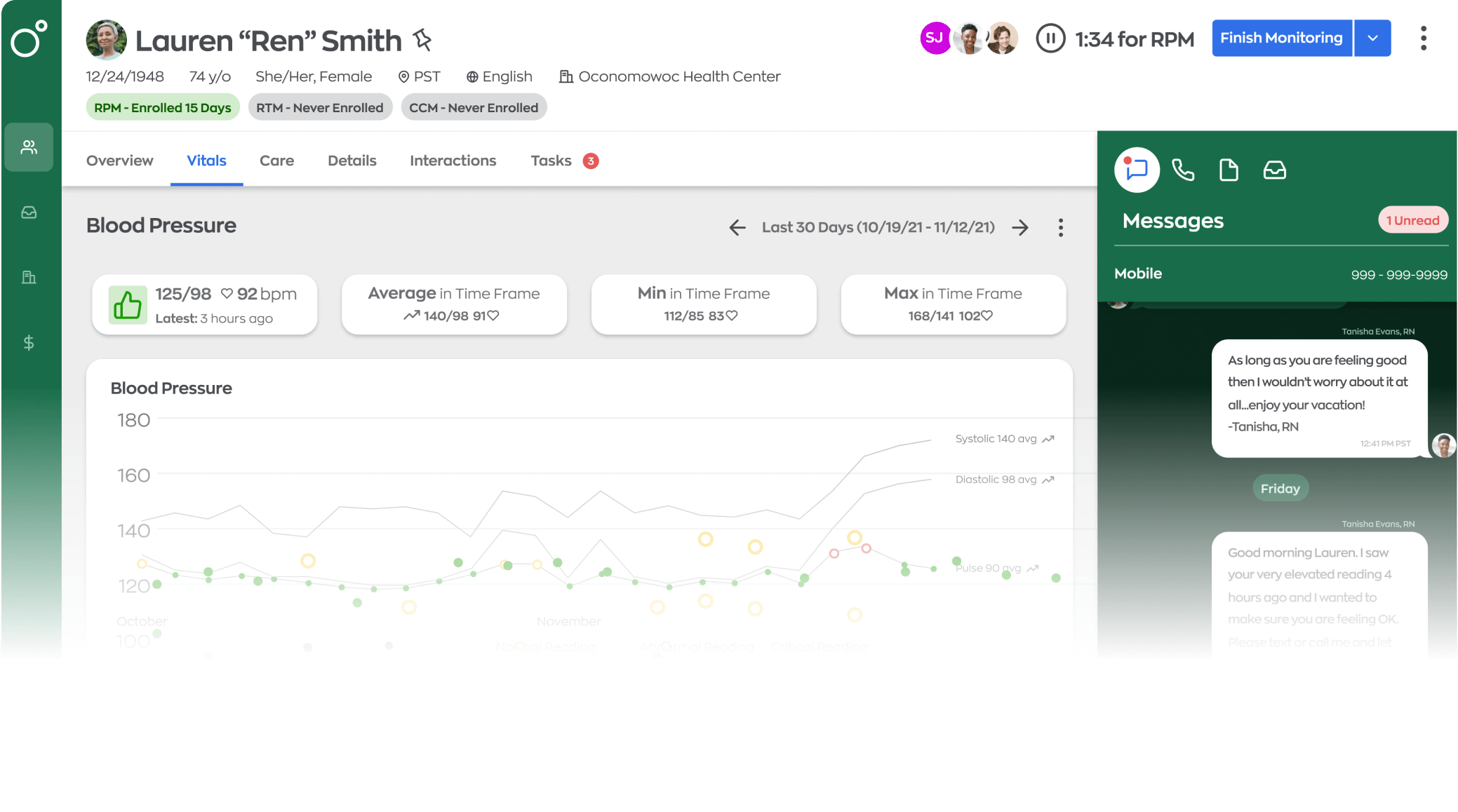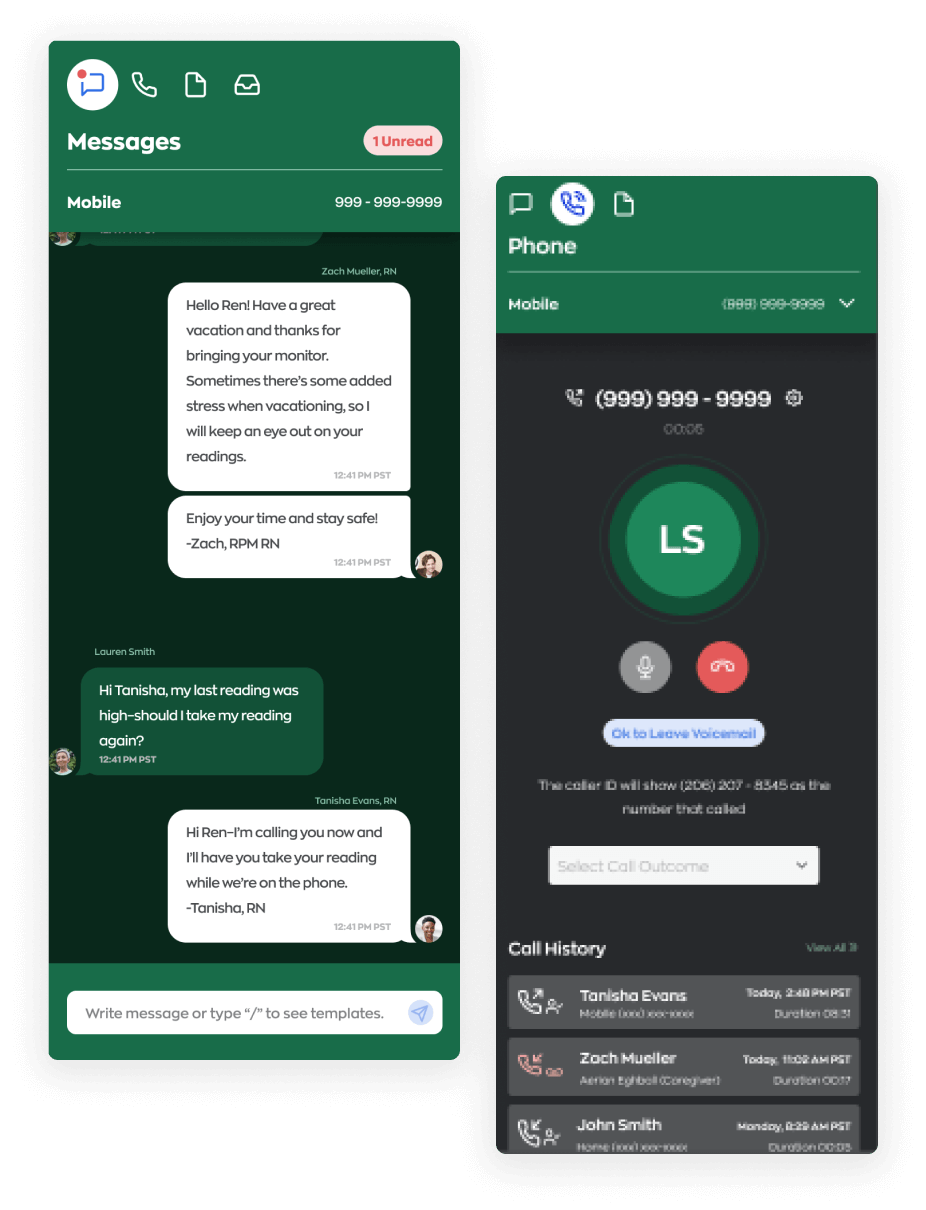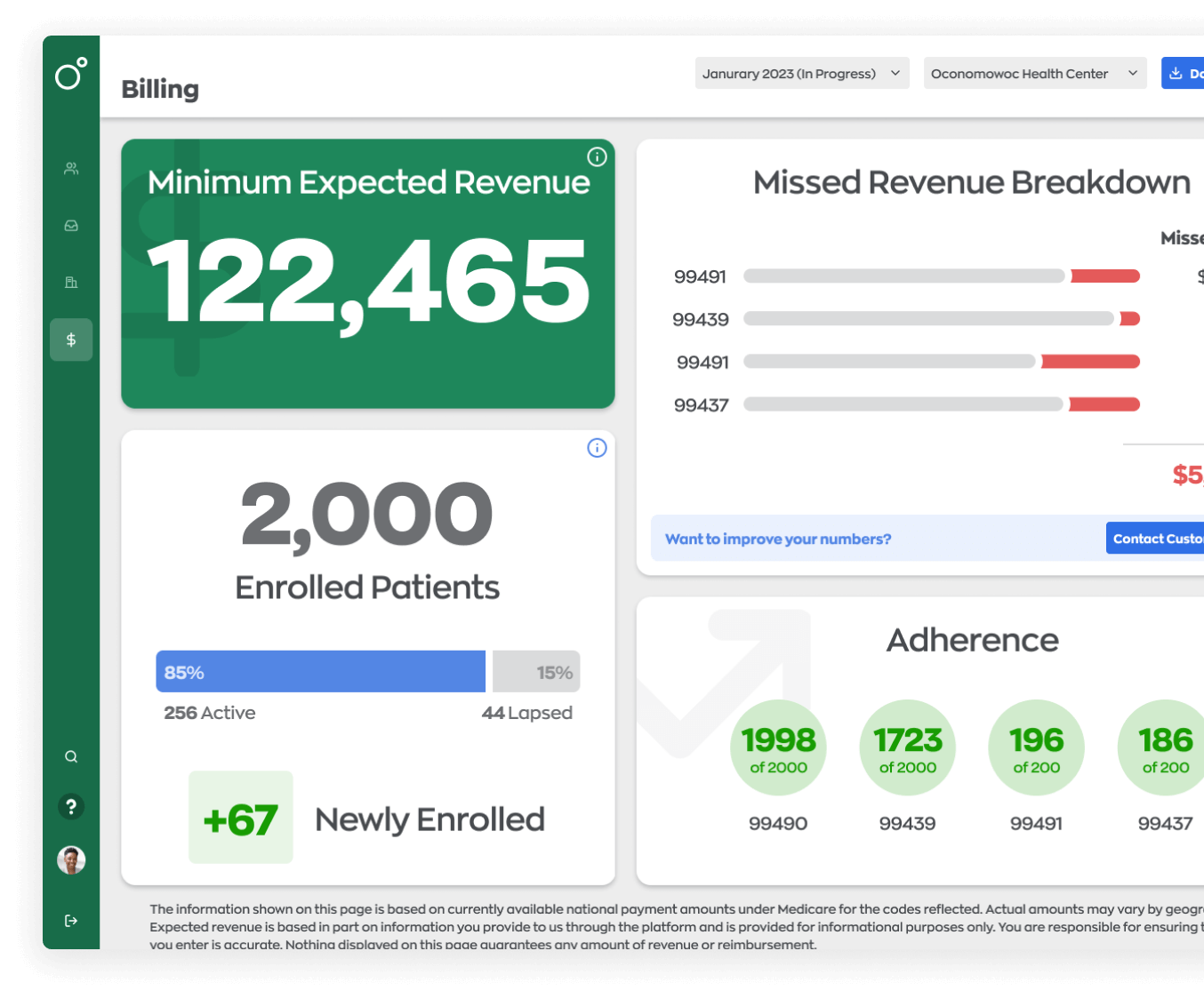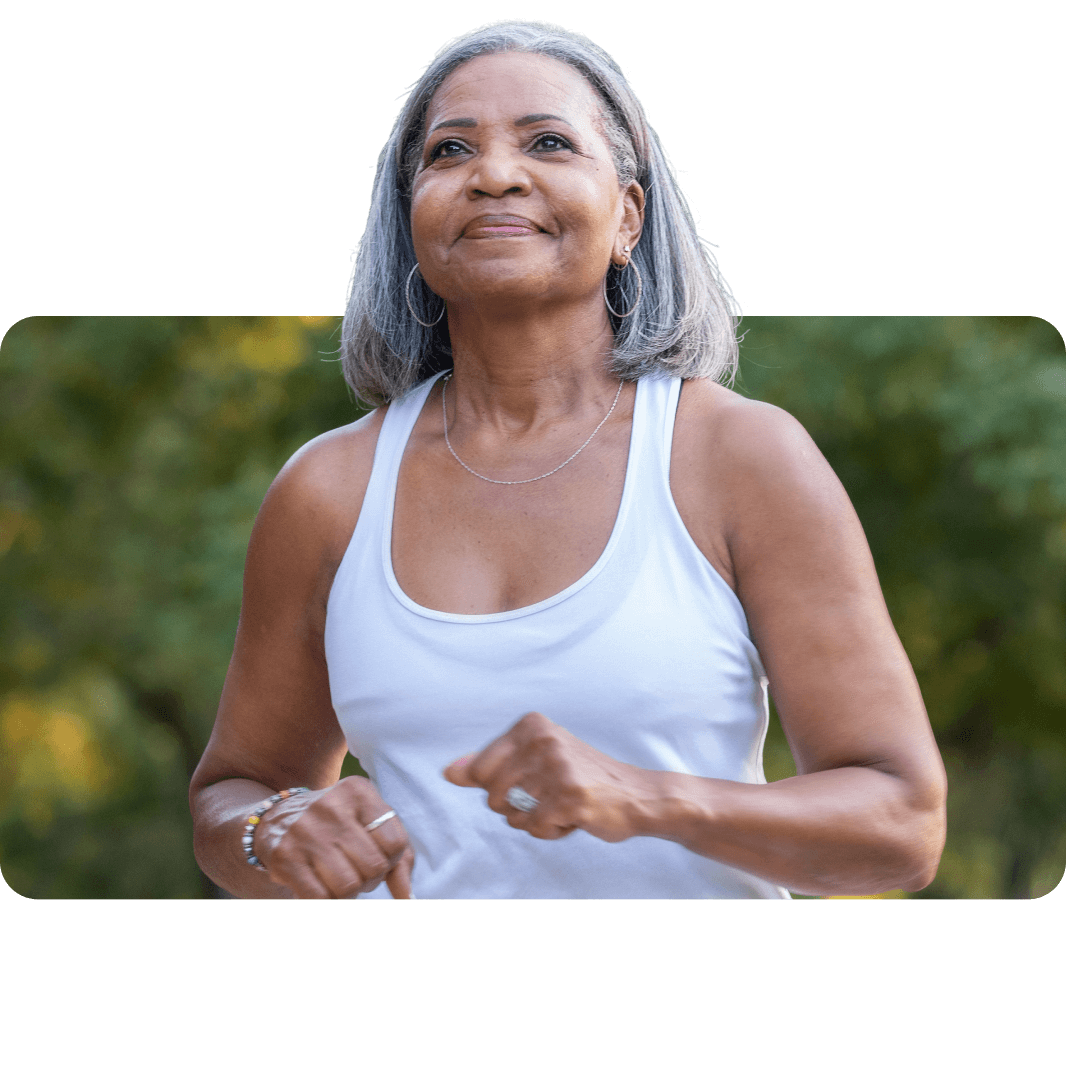
Deliver Better Healthcare Outcomes Starting Today
Optimize Health's remote patient monitoring software gives your healthcare practice the tools it needs to deliver better healthcare outcomes, greater patient engagement, and more revenue per customer. Right now. Today.
Request a Demo
Improved Outcomes, Happier Patients
Optimize Health's remote patient monitoring platform is a simple-to-use system for healthcare providers like yours to provide improved, more modern healthcare. Maximize your time, increase patient engagement, and simplify your ability to monitor and deliver effective treatment plans for a huge range of patients.
Request a Demo
Top-Notch Patient Care Every Day
Optimize Health delivers everything you need to provide the best patient care from one source, to or from any location. Patient health data is sent directly to our secure remote care monitoring platform where you can monitor and analyze it without the need for patient practice visits. Clinical workflows guide you to the best action, every time.
Seamlessly Track Individual Patient Progress
Centralized call history, patient notes and contact preferences supported by global search functionality, enhanced calling features, real-time notifications and message templates make delivering the best patient care a walk in the park.

Total Revenue and Program Potential in One View
Billing Dashboard displays patient billability and expected revenue so you’re not left guessing.
+ Measure program health against total revenue potential
+ Revenue calculated based on total patients enrolled and billing eligibility
+ View patient adherence by CPT code

Remote Patient Monitoring Devices
-
Remote Patient Monitoring Devices
You have two patients, Dana and Pat, who struggle with chronic illnesses. Dana sometimes forgets to take prescribed medications, and Pat’s blood pressure is still too high. You are concerned that their conditions may worsen by their next office visits. You give each a remote patient monitoring device so you can detect problems early. You can then analyze the monitoring device’s data and provide immediate solutions.
A Closer Look at Remote Patient Monitoring Devices
A monitoring device is standard medical equipment designed to connect and transmit data to your office. Here are a few common examples of remote patient monitoring devices:
- Blood pressure cuff
- Glucose monitor
- Pulse oximeter
- Scale
- Thermometer
- Stethoscope
These continuous health monitoring devices send valuable data from the patient’s home to your remote patient monitoring platform. The devices are convenient and easy to use. Once they’re correctly in place, the patient has little else to do. Meanwhile, you use real-time data to set goals and track progress or problems.
You also build better provider-patient relationships. A patient is no longer on their own at home juggling medications, complications, fears, uncertainties, and lifestyle changes. They learn to participate in their own care, become more knowledgeable, and feel less helpless. You become more than a person they occasionally see for a few minutes at a time. Knowing you are there, they feel safer.
-
Remote Patient Monitoring Wearables
Remote patient monitoring devices are handheld, implanted, standalone, or wearable. Remote patient monitoring wearables are rapidly evolving. As technology advances, remote patient monitoring companies are designing devices increasingly capable of collecting and transmitting valuable, real-time data.
The Pandemic Effect
The COVID-19 pandemic accelerated remote device development. Conveniences became necessities for isolated, chronically ill patients. The healthcare industry responded to increased demand. In a survey of healthcare industry CFOs, 60% intended to invest in remote monitoring technology.
Further, the Food and Drug Administration issued the FDA Remote Patient Monitoring Guidance, allowing the modified use of devices to lower the risk of exposure to COVID-19 for both providers and patients.
Wearable Devices
Wearable remote vital sign monitoring devices make data collection easy. Smartwatches and wristbands monitoring vital signs during physical activity have even become commercially popular.
For chronically ill patients, standard wearable devices include:
- Blood pressure cuff
- Pulse oximeter
- ECG
- Activity tracker
The FDA’s guidance also covers an extensive list of devices, including such wearables as:
- Spirometer
- Apnea monitor
- Cardiac monitor
- Sleep assessment device
Wearable devices are non-invasive and comfortable to wear for the time it takes to get a reading and transmit the data. Patients do need a little training before their first use. Optimize Health’s remote patient services can manage your patients’ onboarding and instruction for you.
-
Remote Patient Monitoring Software
Vital information from remote patient monitoring devices feeds into your office’s sophisticated remote patient monitoring software. The best remote patient monitoring companies offer platforms with detailed patient records and the latest data streaming from monitoring devices. Optimize Health‘s platform presents a unique, single resource for each patient to manage remote care—both principal and chronic.
The Remote Patient Monitoring Platform
Imagine office visits with time to analyze several days’ blood pressure and blood glucose measurements. What if you detected setbacks and problems as they happened, and you could address them before they escalated?
Remote patient monitoring software extends your reach to your patient’s home. Instead of relying solely on data collected in one office visit, you have access to hundreds of data points transmitted every day.
The best remote patient monitoring companies are constantly growing the capabilities of their software. Optimize Health’s platform is on the leading edge. With your patients’ data all in one place, you manage remote, chronic, and principal care together, resulting in highly personalized plans and better outcomes.
An Ideal Solution for Chronic Conditions
Data from remote patient monitoring systems greatly enhance your ability to treat a variety of chronic conditions, such as:
- Asthma
- Diabetes
- Heart disease
- High blood pressure
- Obesity
- Pulmonary disease
- Sleep apnea
All Data, All at Once with the Optimize Health Platform
Remote patient monitoring platforms are designed to provide long-term data. For each patient, you can:
- Create goals to achieve
- Monitor symptoms
- Identify and address problems quickly
- Track the effectiveness of medications
- Address any obstacles in the way of your goals
With all patient data in one place, you easily navigate to your patients’ records from a dashboard listing all patients and their latest readings. You select the patient and quickly delve into trends, manage notifications and communications, and more. Spot critical readings that need your immediate attention. Set benchmarks and baselines to plan and implement highly personalized, practical solutions.
-
Benefits of Remote Patient Monitoring
The benefits of remote patient monitoring are plentiful. From saving time and money to improving patient outcomes, remote monitoring give you the information you need to make sound, personalized decisions. Patients get more frequent, high-quality access to you and your expertise.
Low Risk of Exposure
Patients with chronic health conditions are more susceptible to illnesses and the germs lingering among the general population. But they still need their doctors. Remote patient monitoring devices deliver vital data to healthcare providers while eliminating the risk of illness and infection from the outside world. Further, remote monitoring avoids the pain and discomfort travel may cause.
Reduced Costs
Remote monitoring reduces costs in terms of time and money associated with an office or hospital visit. For some patients, add the cost of transportation; they may not be able to drive themselves. With the data remote monitoring produces, you can detect and address problems quickly so they do not worsen and eventually require expensive services.
Health Equity
Access to quality healthcare is challenging for some people living in remote rural areas or underserved communities. Chronic diseases lead to more significant mortality and medical costs. Access to wearable health monitoring devices can be the key to bridging the gap between need and availability.
Patient Involvement
Remote patient monitoring device examples include:
- Activity tracker
- Apnea monitor
- Blood pressure cuff
- Cardiac monitor
- ECG
- Pulse oximeter
- Stethoscope
- Thermometer
As your patients learn to use their devices, they become more aware of their conditions and can better connect their actions (e.g., taking their medications or losing weight) with improved health. Your patients become your partners in achieving their goals.
Patient-Provider Relationship
One day, you notice that a patient’s blood glucose is higher than it should be. You contact the patient and discuss what to do. You answer their questions and reassure them. This kind of contact, conducted outside of the confines of your office, builds a greater level of trust and appreciation.
-
Remote Patient Monitoring Business Model
Value-Based Healthcare
A remote patient monitoring business model aligns with a value-based approach to healthcare. The New England Journal of Medicine describes this as a system where providers’ compensation is linked to patient outcomes rather than office visits and services. This increases the quality of care while lowering costs.
Support from Optimize Health’s Software and Services
Consistent with value-based care, the Optimize Health platform’s remote patient monitoring devices inform you of your patient’s condition in real time. In addition, Optimize Health’s support services help you further enhance the quality of care with:
- Patient onboarding, education, and adherence
- Management of issues related to insurance, HIPAA, and payors
- Device delivery
- Monthly reports
The success of remote monitoring relies on the proper use of the devices. The Optimize Health services ensure patients receive the devices they need, know exactly what to do, and use their devices consistently. You receive regular reports and monthly meetings to track results.
A Few Remote Patient Monitoring Statistics
- About 11% of Americans will use remote monitoring within the following year.
- 38% of organizations using remote monitoring experienced fewer admissions, and 17% lowered costs.
An MSI International survey reported:
- Up to 70% of participants welcome remote monitoring.
- Participants cite convenience, healthcare participation, and accurate information among program benefits.
-
What Is Remote Patient Monitoring Used For?
How Remote Patient Monitoring Works
Anne has diabetes and high blood pressure. It’s difficult for her to manage them both on her own, even though she follows her doctor’s instructions to the best of her ability between office visits.
After a recent hospitalization, Anne’s doctor gave her remote patient monitoring devices to check her blood pressure and glucose levels. With data transmitted to the doctor every day, Anne welcomed calls from the doctor’s office checking on her and answering her questions. Both conditions improved, and her relationship with her doctor eased her anxieties.
This example of remote patient monitoring highlights a simple program with enormous benefits in a value-based approach to healthcare.
Optimize Health Case Studies
Optimize Health’s case study of remote patient monitoring at Lake Oconee Primary and Urgent Care Center brings the value of remote patient monitoring (RPM) to light. Providers were seeing chronic care patients only every three to six months. It was impossible to truly manage chronic illness with such large time gaps between patient-provider interactions. They found their solution when they adopted Optimize Health’s RPM software and RPM equipment. This system allowed them the customization and services to fully address their patients’ needs. They now monitor more than 100 patients.
Kidney Disease Consultants‘ nephrology patients typically suffer from chronic conditions such as diabetes and high blood pressure. The time between office visits was often months, so patients were at high risk for complications. The Optimize Health platform helped them slow disease progression and reduce mortality. They lowered the hospitalization rate by 30%. Their program grew by 200% in only two months, so they added an RPM Lead to their staff.
A Bright Future Ahead
RPM companies are at the forefront of the new value-based healthcare approach. With their real-time data, you make better decisions, discover problems before they escalate, and provide solutions.
In the eyes of your patients, you become a guide and a resource for answers, reassurance, and peace of mind. They are not alone in their chronic struggle. They have you!
References
American Hospital Association (n.d.). A New Era Begins in Connected Health at Home. Retrieved June 30, 2023, from https://www.aha.org/aha-center-health-innovation-market-scan/2021-01-19-new-era-begins-connected-health-home
American Hospital Association (n.d.). Is Health Care on the Threshold of a Remote Patient-Monitoring Boom? Retrieved June 30, 2023, from https://www.aha.org/aha-center-health-innovation-market-scan/2023-03-07-health-care-threshold-remote-patient-monitoring-boom
Lanboley, L. (n.d.). 27 Remote Patient Monitoring Statistics Every Practice Should Know. Retrieved June 30, 2023, from https://blog.prevounce.com/27-remote-patient-monitoring-statistics-every-practice-should-know
Muller, E., MPH (n.d.). 7 Common Remote Patient Monitoring Devices. Retrieved June 30, 2023, from https://www.healthrecoverysolutions.com/blog/7-common-remote-patient-monitoring-devices
US Health & Human Services (n.d.). Telehealth and remote patient monitoring. Retrieved June 30, 2023, from https://telehealth.hhs.gov/providers/preparing-patients-for-telehealth/telehealth-and-remote-patient-monitoring
New England Journal of Medicine (2017, January 1). What Is Value-Based Healthcare? NEJM Catalyst. Retrieved June 30, 2023, from https://catalyst.nejm.org/doi/full/10.1056/CAT.17.0558|https://catalyst.nejm.org/doi/full/10.1056/CAT.17.0558
Prieto-Avalos, G., Aracely Cruz-Ramos, N., Alor-Hernández, G., Sánchez-Cervantes, J. L., Rodríguez-Mazahua, L., & Guarneros-NolascoNational Libr, L. R. (n.d.). Wearable Devices for Physical Monitoring of Heart: A Review. National Library of Medicine. Retrieved June 30, 2023, from https://www.ncbi.nlm.nih.gov/pmc/articles/PMC9138373/
Samet, A. (2022, October 4). The technology, devices, and benefits of remote patient monitoring in the healthcare industry. Insider. Retrieved June 30, 2023, from https://www.businessinsider.com/10-4-2022-remote-patient-monitoring-industry-explained
Sanders, S. F., Stern, A. D., & Gordon, W. J. (n.d.). How to Make Remote Monitoring Tech Part of Everyday Health Care. Harvard Business Review. Retrieved June 30, 2023, from https://hbr.org/2020/07/how-to-make-remote-monitoring-tech-part-of-everyday-health-care
US Food and Drug Administration (n.d.). Enforcement Policy for Non-Invasive Remote Monitoring Devices Used to Support Patient Monitoring During the Coronavirus Disease 2019 (COVID-19) Public Health Emergency (Revised) Guidance for Industry and Food and Drug Administration Staff. Retrieved June 30, 2023, from https://www.fda.gov/media/136290/download#:~:text=FDA%20is%20issuing%20this%20guidance%20to%20provide%20a,the%20duration%20of%20the%20COVID-19%20public%20health%20emergency
US Health and Human Services (n.d.). Health equity in telehealth. Retrieved June 30, 2023, from https://telehealth.hhs.gov/providers/health-equity-in-telehealth
Expand your approach to patient care.
